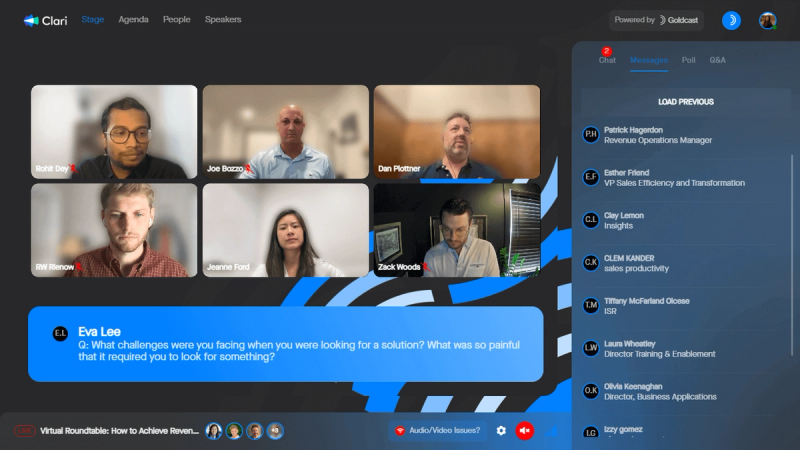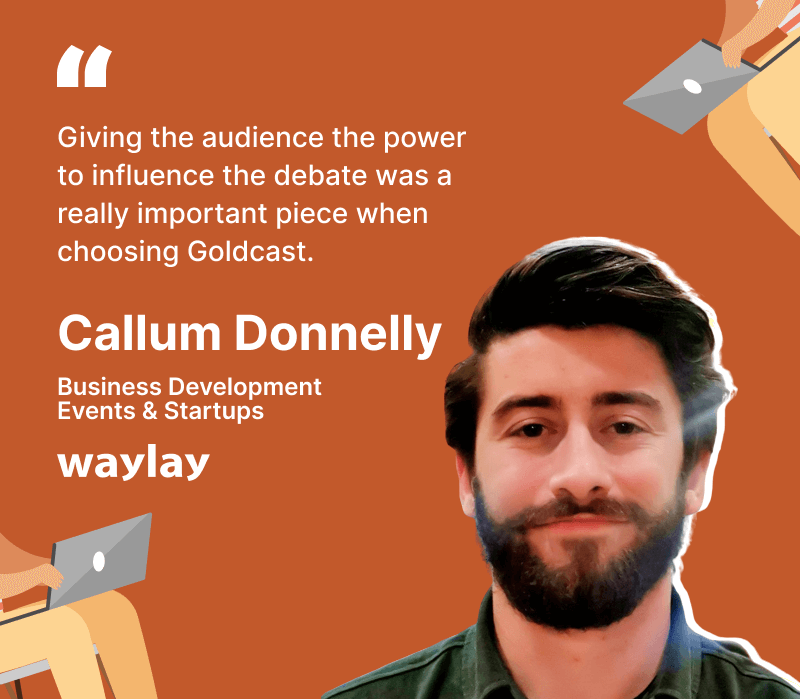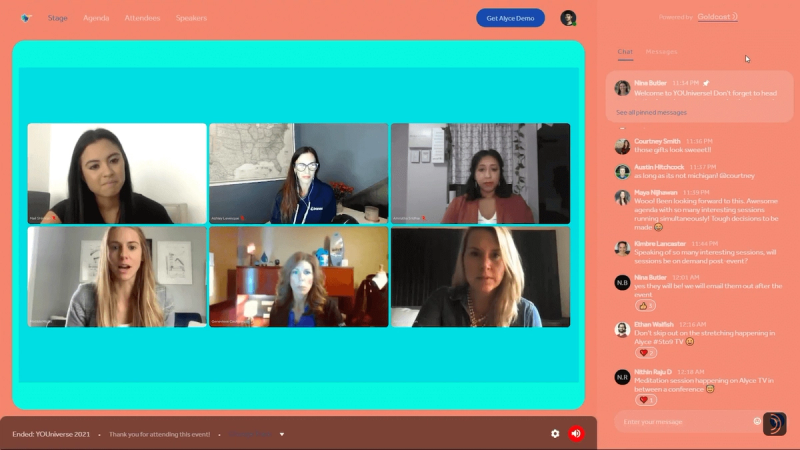9 High-Impact Webinar Formats to Cut Through the Noise

Table of Contents
Maximize Your Marketing ROI
Join 10,000 other marketers already getting the best tips on running engaging events that boost pipeline and create raving fans.
Believe it or not, webinars have been kicking around since before the dawn of Amazon shopping. As one of the oldest and most trusted event formats, you can think of them as the extinction-proof dinosaurs of the virtual event marketing world. 🦖
But over the years, webinars have evolved to meet the ever-changing needs of users. In fact, today’s webinar formats are so diverse that the very definition of what a ‘webinar’ is can deviate greatly depending on who you ask.
At Goldcast, we've seen organizations take a variety of approaches to their webinar strategies depending on a variety of factors, such as:
- The goal of the webinar
- Where it sits in the marketing strategy
- And who within the company owns it
While there's no one way to create a successful webinar strategy, there are some classic webinar formats that can help you keep attendance, engagement, and event ROI high.
4 timeless webinar formats:
- The Q&A or ‘ask me anything’
- The expert panel
- The 5 x 15
- The product demo
📈 Stay up to date with the latest trends in our B2B Webinar Benchmark Report
First things first: What should be included in a webinar?
Back in the mid-1990s, webinars got away with offering the bare minimum — a virtual location for people to meet, a topic to discuss, presenter to lead, and some sort of visual display to sit back and watch.(Because let’s face it, pretty much anything the early webinar offered was a big step up from the “multimedia” presentations of today. 📽️)
Fast forward a couple of decades, webinars look a whole lot different. And the expectations around what qualifies as a best-in-class webinar have skyrocketed.

Today, the webinar market is expected to reach $800 million by 2023 with a whopping 99% share of companies saying the event format is critical to their marketing plan.
To rise above the noise and launch a webinar that won’t be forgotten, modern event marketers can’t afford to rely on a speaker, slide deck, and webcam to get them there.
So what should be included in a high-engagement, high-impact webinar? Here are the things to think about when mapping the format for your next webinar:
- Content: Next-level webinar content means finding a topic people genuinely want to hear about and producing it in a way that will hold their attention.
- Delivery: How you’re going to deliver that content matters (hint: you’ll want to steer clear of the played-out bullet-point presentations!)
- Engagement: Know how you’ll keep your webinar engagement high — look for ways to include personalization, gamification, and networking opportunities.
- Platform: Take your time to find the right webinar platform. You’ll want something dynamic — think: feature-rich ✔️ data-driven ✔️ and heavy on the support. ✔️
- Equipment: The event equipment you’ll be using is important — glitchy wifi and grainy cameras are an instant turn-off for modern webinar attendees.
- Accessibility: Make sure your event is available and inclusive to everyone who wants to attend.
Your webinar format is the foundation you’ll set to grow your webinar strategy and all the ROI that comes with it. Take time to ensure your format aligns with both your audience’s needs and your team’s internal goals.
💡 If you’re looking for better ways to align broad event goals with clear objectives you can act on — we’ve got you covered. Check out these 14 Examples of Virtual Event Goals and Objectives and get the inspo you need to knock your next event out of the park!
4 classic webinar formats to set your brand apart
With webinars as the virtual event of choice for nearly 95% of B2B marketers, it’s clear they have a lot to offer.
For your webinar to deliver the winning combination of an awesome attendee experience and increased revenue for your organization, take a moment to get clear on the fundamentals:
- What stage of the marketing funnel are your webinar attendees in?
- e.g., top, middle, bottom, post-sales, etc.
- What type of information will be most useful to them?
- e.g., industry, product, high-level, details, etc.
- What is your end goal for the event?
- e.g., brand awareness, pipeline velocity, conversion, upsell, etc.
No matter the goal or audience, these model webinar formats will help you deliver.
1. The Q&A or ‘ask me anything’ webinar
Best for: Top-of-funnel leads and prospects
Not everyone is going to be after the same insights on the same topics when they sign up for a webinar. If you’re really looking to give attendees the opportunity to get involved and have their questions answered, the ‘ask me anything’ (AMA) webinar format is a great way to go.
Whether it’s a well-known leader from your own organization, a partner, sponsor, or industry expert — the classic Q&A webinar format allows speakers to peel back the curtain on the hottest topics attendees actually care about.
An action-packed Q&A gives attendees the rare opportunity to ask questions directly or share their own opinions in a candid open-mic experience.
✅ Pros of the Q&A or AMA webinar format
- By placing the power in the hands of the attendee, you’re allowing them to guide their own experience and personalize it to meet their needs.
- With the right virtual event technology you can even provide attendees with an opportunity to submit live video questions on stage.
❌ Cons of the Q&A or AMA webinar format
- If you have a shy audience or topic that’s too niche, you may end up low on questions and things could get…awkward.
💡 Event marketer pro tips for this format
- AMA sessions are awesome, but they can be prone to veering off track — have a moderator there to keep things ticking at the right pace.
- Make sure your moderator has guiding questions prepped, just in case.
- Use polls to gather a group consensus if questions are slow coming.

2. The expert panel
Best for: Middle-of-funnel decision makers
The expert panel discussion format is a great way to bring industry thought leaders together and let them loose on topics at the cutting edge of their industry or field.
Attendees get a front row seat to unfiltered discussions and debates that help demystify the latest developments in the industry, while taking an active part in the conversation.
As with the Q&A format, you can invite listeners to get involved by submitting questions and answering interactive polls in real-time. But while AMA webinar formats tend to be led by attendees, the expert panel webinar format is guided more by the host — a.k.a. you!
✅ Pros of the expert panel webinar format
- With panels you have greater control over the narrative and can organically raise topics important to your audience or brand.
- With a wider array of speakers, panels are a great way to draw in attendees. Expert panelists can also help market your webinar to boost those registration numbers.
❌ Cons of the expert panel webinar format
- With great panels comes great…preparation. Because you’re leading a discussion with multiple speakers, you’ll need to put in extra time and energy to recruit your panel, choose a topic that works for everyone, and generate relevant questions.
💡 Event marketer pro tips for this format
- Choose panelists who are reliable, knowledgeable and compelling to listen to.
- Make sure your host or moderator is familiar with each panelist’s background, comfortable with the topic, and able to diffuse any potentially heated debates.

When it comes to bringing industry rockstars together, the event marketing team at Alyce knows how to raise the bar. Learn more about how they made events their second-highest pipeline generating channel!
3. The 5 x 15 webinar
Best for: Mid- to- bottom of funnel knowledge seekers 🧐
If you want to make sure your attendees leave your webinar bursting with knowledge and inspiration, micro sessions are a great way to turn up the education factor.
Instead of delving deep into a single topic, the 5 x 15 webinar format means you can cover five totally independent subjects, for fifteen minutes each, keeping your audience engaged throughout.
That means you could:
- Introduce your brand
- Give your sponsors a shout-out
- Touch on the latest industry news
- Demo a new product
- And conduct a ‘how-to’ tutorial
… all-in-one single webinar lasting under 90 minutes. #eventefficiency
✅ Pros of the 5 x 15 webinar format
- You have multiple opportunities to connect with attendees — if one session isn’t floating their boat, you have four more oars to hand out.
- With a 5 x 15 agenda it’s only ever a short wait until the next session, making it easier to increase both your show rate and total time in event.
❌ Cons of the 5 x 15 webinar format
- The prepwork for a 5 x 15 webinar format is significant — though sessions are short, you’ll still need to decide on topics, research each one, create your content, and potentially find multiple speakers to deliver it.
💡 Event marketer pro tips for this format
- Always aim to keep your 5 x 15s relevant throughout. If you flip between topics without any obvious links, sessions can feel disjointed or confusing.

Source: Markletic
4. The product demo
Best for: Bottom-of-funnel prospects and post-funnel upsell opportunities 💰
Product demo webinars are known as a great way to move the needle with high intent prospects, but they’re also a largely untapped opportunity to educate your existing customer base — explaining your latest feature, demoing your cool new product or service, or even trouble-shooting common user errors.
And these days, there’s no excuse not to make these product-led sessions an immersive experience for your audience.
Whether it’s hosting an exclusive post-event demo with a member of your product team, delivering an in-platform demo so attendees can ask their questions live, or offering hands-on help via virtual booths — the demo webinar allows you to talk about your product offer (without being pushy about it).
✅ Pros of the product demo webinar format
- Product demos are a great excuse to catch up with both new prospects and existing customers.
- With the right event data, you can track attendees throughout the customer journey for a direct attribution between your webinar and increased sales, upsells, and product usage.
❌ Cons of the product demo webinar format
- Getting the vibe right for product demos can be a tricky line to toe. Attendees are ready to be sold to, but they’re expecting to enjoy themselves too. If your product or feature doesn’t feel fun and organic, this can be a challenge.
💡 Event marketer pro tips for this format
- To liven up a product demo, go all in on engagement — think: gamification, networking, and personalization to take the focus off the selling and put it back on the attendee.

Want to win with webinars? Focus on format. ✔️
Webinars have come a long way.
But as crucial as they are, 53% of business professionals say there are simply too many webinars around right now. To win them over, it’s vital you position your live event to cut through the noise, secure more registrations, and keep attendees coming back for more.
With the right webinar format, it’s never been easier to do exactly that.

Transform Your Video Marketing with AI
Stay In Touch
Platform
Resources
© 2025 Copyright Goldcast, Inc. All rights reserved.





 Upcoming Events
Upcoming Events Event Series
Event Series On-Demand Events
On-Demand Events

